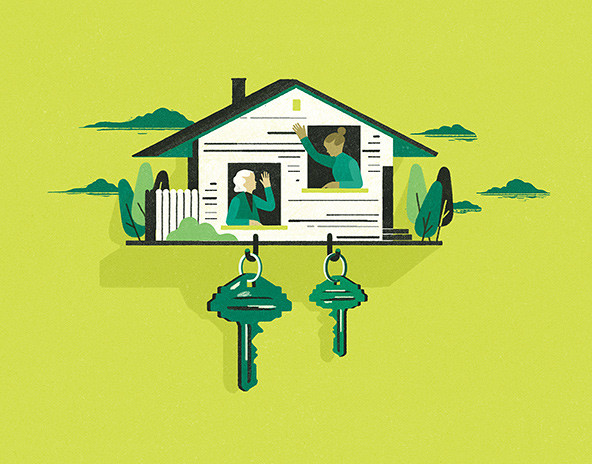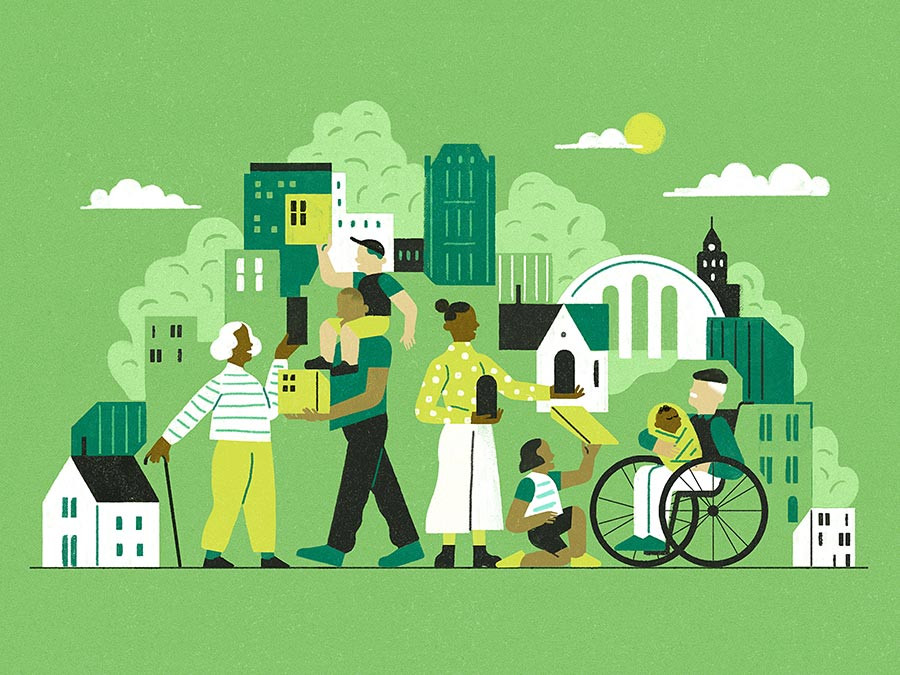 (Illustration by Gracia Lam)
(Illustration by Gracia Lam)
The policies and resources devoted to housing security for Americans fall devastatingly short of meeting the need. Since 2017, nearly half of renters have spent 30 percent or more of their incomes on housing costs—an unsustainable portion, according to The US Department of Housing and Urban Development. And today, an unprecedented and long-term housing crisis looms, with an estimated 40 million Americans at risk of eviction, many of whom lost their jobs during the COVID-19 pandemic. This rental housing crisis disproportionately affects people of color, in part due to systemic racism in the mortgage industry, as well as younger generations whose homeownership rates have plummeted far below that of their parents' generation.
At the same time, an astounding 54 million spare bedrooms sit empty every night. Many of these spare bedrooms are located in the homes of older Americans, with millions more expected over the coming years. In fact, by 2035, one-third of all households in the United States are projected to be headed by someone age 65 or older, and more than half of these will be single-person households. Research shows that the vast majority of men and women over 50 want to stay in their current homes and communities as they age. Yet many face steep barriers to doing so, including insufficient fixed incomes and retirement savings, rising home maintenance costs and property taxes, and the debilitating health effects of loneliness and social isolation.

And so, we have two problems: Large numbers of renters—including many young, low-wage workers and students—are having a hard time finding affordable places to live, while growing numbers of older adults with space in their homes need extra income and companionship. One solution tackles both: intergenerational home-sharing.
A New Way to Do Old Things
Throughout US history, urban newcomers, including young and unmarried workers, commonly lived with older couples or widows. Scholars estimate that in the late 19th century as many as half of all urban Americans spent time as boarders living in others' apartments and homes. But at the start of the 20th century, concerns about overcrowding sparked public health campaigns that virtually eliminated this popular, low-cost housing solution.
With metropolitan areas in the United States and other countries now facing severe affordable housing shortages and older adults becoming the fastest growing population in many cities, there's renewed interest in multigenerational living. Some older adults are rejecting the idea of retirement communities and opting for co-living arrangements with housemates of varied ages. Meanwhile, some nursing or assisted living homes in areas like Ohio, California, Finland, and the Netherlands are opening up rooms to millennials willing to offer companionship to older residents in exchange for low rents.
Alongside these new types of living spaces is a resurgence of small-scale home-sharing programs. The National Shared Housing Resource Center lists about 40 formal, non-profit, home-sharing services in the United States, such as Odd Couples Housing in St. Louis, which mostly matches students with older adults, and Home Match San Francisco, which has attracted young working professionals and students who can't afford the city's steep rents.
The benefits of age-integrated housing are tangible and wide-ranging, as we've seen through our work at Nesterly, a technology-driven home-sharing marketplace. Nesterly offers a safe and easy way for older adults to rent spare rooms to young people who need an affordable place to live for more than a month. By opening their homes, older adults can gain monthly income, household support (such as grocery shopping, dog walking, or meal preparation) in exchange for lower rent, and even a new friendship. "I feel comfort coming back at night to a home with lights on," said Brenda Atchison, an empty nester in her late 60s, who in recent years has rented rooms in her Boston home to several young people through Nesterly.
Insights for Home-Share Innovators
Over the past two years, Nesterly has helped unlock hundreds of affordable housing units in Boston and Columbus, Ohio, and has learned some valuable lessons in building an enterprise that bridges generations. Here are four insights that may help others considering working in the burgeoning age-tech space:
1. Recognize the complexities and promise of public-private partnerships. Public-private collaborations can generate solutions that neither sector can easily create alone. Mayors around the United States, for example, are under pressure to increase the supply of housing, provide support for seniors, and address gentrification and housing instability. They need novel solutions, but it's not easy for them to allocate budgets for innovation and technology development at the municipal level, especially at a time when already-strapped local governments are facing severe budget shortfalls due to the economic effects of COVID-19.
Nesterly's initial prototype was developed in 2017 through a public-private partnership with the city of Boston's Housing Innovation Lab, a team charged with testing and accelerating innovation in the affordable housing sector. As a private enterprise, Nesterly was able to absorb the cost of research and development by leveraging its own expertise in urban planning and technology. Nesterly also shielded Boston's city government from operational liability, thereby lowering the barriers to entry for the city to fund and shape a solution, and quickly bring it to market. At the same time, Boston's early participation helped us circumvent potential regulatory hurdles, and generate trust and wider user adoption. Once the model proved successful, the Mayor's Office and several municipal agencies focused on senior services, housing security, and housing development came together to further fund and scale the platform.
2. Shifting perceptions and behavior requires creativity. With urban housing prices soaring, it's not surprising that young renters are eager to fill rooms listed significantly below-market-rate rents (in our case, 20-40 percent lower). But persuading older adults that it's both safe and advantageous to share their home via an app is a bigger challenge.
First is the quandary of how to reach them. While more than half of adults over 65 own smartphones, and many are active on social media sites like Facebook, we had to use a mix of traditional and digital marketing channels to build trust and reach a wide segment of the older population. Nesterly relies as much on referrals from nonprofit organizations, including senior service providers and city agencies, as it does on digital ads.
We also found that storytelling is a powerful method for breaking down preconceived risks and normalizing the notion of home-sharing—whether through media, peer-to-peer referrals, or blogging. For instance, the firsthand story of Nellie in Cambridge, a recent widow who enjoyed gardening and exchanging favorite poems with a graduate student, humanized the notion of home-sharing in a visceral way, and we initially shared it through an NPR video feature. Past videos of other intergenerational home-sharing models have even gone viral.
3. Accessible technology has the power to transform senior services. Technology has great potential to democratize and scale social innovations. Whereas past home-sharing models have largely failed to reach a critical mass, Nesterly's scalable technology platform has inspired interest and support from a range of municipal and federally funded service agencies. That's not surprising at a time when the cost of constructing new units of affordable housing ranges from $100,000 to a reported $800,000 per unit and when overall public investment in housing is declining. But building effective, digital-first services for seniors requires an acute focus on making them relatable and accessible. And because intergenerational home-sharing is a new industry, there's no playbook for how to do it well.
Indeed, we learned that building human-centered technology, designed with empathy and age-appropriate principles, required a pioneering mentality. There were no shortcuts. We challenged industry norms for site copy, colors, font sizes, and navigation structures by actually testing them with older audiences. We were surprised to find that terms and symbols that felt intuitive to our team didn't translate to the population we were designing the service for. After significant investment in experimentation and multiple iterations, we created a web platform that serves a range of users with varying technology skills.
It's also important to remember that accessible technology extends beyond website design and functionality; we learned that customer support can play a major role in widening user adoption and improving user satisfaction. An experienced gerontology social worker leads our customer service team, employing interactive tools like screen sharing and over-the-phone guidance to troubleshoot issues when they arise. And to ensure that no user is barred from the platform due to lack of access or fluency in technology, Nesterly created a special log-in system for co-account holders so that relatives or trusted friends can safely help operate seniors' accounts.
4. One size doesn't fit all; flexibility matters. To reach a wide audience, it's important to take into account differences in users' lifestyle preferences as much as possible.
For instance, in Nesterly's case, both older adults and young people open to living with seniors have a wide range of motivations for wanting to rent a spare room. Nesterly built in a base level of features that provide safety and assurance to users, while also leaving room for the individualization of home shares. For instance, we conduct background checks on both homeowners and potential renters (contacting former landlords for reference checks) when they sign up, as well as offer practical services like automated payments, a customizable rental agreement, and on-going assistance from trained social workers, including guidance to help homeowners set their pricing, length of stay, and whether they want help with tasks around the house. We also provide tools, such as interview guides and an in-app video conferencing feature, to help users clearly communicate what they're looking for in a tenant relationship, whether that's a close friendship or more independent living.
While no one approach can perfectly solve the challenges presented by the confluence of a rapidly aging society and the housing crisis, intergenerational home-sharing models offer communities an innovative, flexible way forward. With an astute approach to scaling and reverent use of technology, home-sharing can help young people access affordable housing near jobs and opportunities, and ensure that our parents and grandparents age with choice and dignity. Indeed, it can help create a world where housing security isn't just for the privileged, it's for everyone.
Support SSIR’s coverage of cross-sector solutions to global challenges.
Help us further the reach of innovative ideas. Donate today.
Read more stories by Noelle Marcus.

